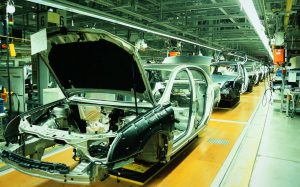5 Simple Truths About Modular Off-Site Construction


Off-site construction is the planning, design, fabrication and assembly of building elements at a location, other than the final location where they will be installed, to support the rapid and efficient construction of a finished structure. There are several different types of off-site construction known as building systems. The modular building system takes a home plan, divides it into modules, and then constructs those modules to a level of finish that can be up to 85% complete in a factory. No other building system has the ability to maximize the advantage that building in a factory can provide.
Truth #1: Modular Design Isn’t Boxy Design (Unless that’s what you want)
When you read the latest architectural design magazines you will see pictures and plans of sleek, boxy, all glass homes with flat roofs. These latest styles show contemporary lines and bright interiors, minimalist furnishings and lots of built-ins. And for many American home buyers, that is a beautiful dream home. Modular construction provides a perfect method to construct and deliver these modern designs very cost effectively with the best that building science has to offer.
But that is not all modular construction has to offer. Modular homes appeal to the masses of home buyers by offering design excellence through classic architecture. While modern architecture offers wonderful design and beauty, most of America still chooses to live in a home that looks much like the one they grew up in.
Truth #2: Modular Increases Construction Productivity
 A building system is essentially a highly engineered process of producing buildings or components of buildings in a highly cost effective and efficient manner. Roof trusses and floor trusses are components that many are familiar with that are produced using a building system. Almost every residential builder today would not imagine building a home without using roof trusses and even floor trusses. Why? Because they are strong, pre-built (built offsite then delivered and set), and cheaper than building those same components on-site.
A building system is essentially a highly engineered process of producing buildings or components of buildings in a highly cost effective and efficient manner. Roof trusses and floor trusses are components that many are familiar with that are produced using a building system. Almost every residential builder today would not imagine building a home without using roof trusses and even floor trusses. Why? Because they are strong, pre-built (built offsite then delivered and set), and cheaper than building those same components on-site.
Modular is actually a design approach. It is a process that divides a system into smaller parts called modules. These modules are built in a factory using many of the components and  subassemblies that are used for onsite construction. These included roof trusses and floor trusses. The advantage is that these components and subassemblies are assembled into larger modules with the assistance of cranes, tooling, and jigs that just aren’t available in field construction.
subassemblies that are used for onsite construction. These included roof trusses and floor trusses. The advantage is that these components and subassemblies are assembled into larger modules with the assistance of cranes, tooling, and jigs that just aren’t available in field construction.
These modules can then be individually created and later, assembled together. The modular process is used in many products we use every day; cars, computers, elevators, furniture, etc. The modular design increases construction productivity by combining the production advantages of standardization with customer demand for customization. It is the smarter way that industries have discovered to produce custom products using standardized modules or assemblies.
Truth #3: Modular Reduces Construction Timeframes
Building in a factory away from the jobsite increases construction efficiency and productivity enables better sequencing in construction processes and reduces weather-related delays. In typical onsite construction, the process is the bottleneck. Everything has to happen in sequence. Building off-site means various aspect of the building is done simultaneously increasing timeframe efficiencies. Overall construction completion timeframes are drastically reduced.
RELATED: MODULAR = GENIUS
An often overlooked part of the modular construction process is that decisions for every item have to be made before a home’s construction is started. Change orders and cost overruns are minimized because decisions have to made early in the process. Making these decisions early may lengthen the planning process but actually reduce the overall construction timeframe.
Truth #4: Modular Maximizes Home Value
The process of modular construction is the equivalent of construction efficiency. Efficiency means planning the entire construction process. The process builds efficiency in many ways. Here are just a couple:
- Better Use of Materials – Material can be bought in the lengths and sized needed versus being cut as needed throwing away the scrap.
- Buying Materials in Bulk – Instead of buying materials by the pickup truck load, factories pull the material needs of many homes together to negotiate better prices with suppliers lowering overall costs.
An often overlooked advantage of faster construction is the reduction in interest and carrying costs. With elaborate custom home construction projects that are financed with a construction loan, there are interest charges every month. These expenses are lost with no tangible long term value. By reducing the overall construction timeframe, money isn’t wasted on interest expense.
Truth #5: Modular Construction is Resilient Construction
Resiliency is the intentional effort to design and construct buildings and landscapes to withstand both natural and man-made disasters. Modular homes are built strong. The basis for modular construction is to build a home that meets or exceeds building code. However, the modules that make up a modular building are built off site and transported to that site. The effort of getting from a factory to the building site is about the equivalent of surviving a hurricane and an earthquake before a module ever reaches a jobsite. It is placed on a carrier, driven at 55 – 65 MPH on highways, over bridges, and around curves. It may have to navigate back roads or tight residential streets. This 20,000 – 60,000 pound module is then lifted in the air by a crane with 2 or 4 straps or cables and placed on a foundation.
The resiliency built into every module is displayed at every modular home installation. In most cases, a module will only suffer from minor, if any, dry wall cracks. Structurally, the modules are stronger than anything that is built onsite. Resiliency is then exponentially increased when each of the modules are then connected with lag screws, bolts, and/or straps upon final installation. The strong interconnections between modules make modular homes extremely resistant to wind events as document in the FEMA study following Hurricane Andrew.
The post 5 Simple Truths About Modular Off-Site Construction appeared first on Impresa Modular.




